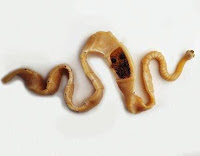1. Platyhelminthes are best described as
a) flatworms, triploblastic , acoelomate animals
b) flatworms, diploblastic , acoelomates
c) flatworms, triploblastic , coelomates
d) flatworms, triploblastic , pseudocoelomates animals
2. An important character which platyhelminthes share with the acnidarians is
a) diploblastic condition
b) single cavity communicating with the exterior
c) three germ layers and no coelom
d) Presence of complicated reproductive system
3. Free living platyhelminthes
forms belong to the class
a) Cestoda
b)Trematoda
c) Turbellaria
d) Nematoda
4. In helminthes, flame cells are component of their
a) reproductive system
b) excretory system
c) nervous system
d) respiratory system
5. Fasciola hepatica is an
endoparasite that lives in the
a) liver of sheep
b) blood of sheep
c) spleen of sheep
d) Intestine of sheep
6. The intermediate host in the
life cycle of Taenia saginata is
a) Pig
b) Goat
c)Dog
d) Cattle
7. Taenia solium lacks
alimentary canal because
a) it does not require any food
b) it lives in the intestine
c) it has saprozoic mode of feeding
d) None of the above
8. Which of the following is called ‘Blood fluke’ of man?
a) Taenia
b) Paragonium
c) Fasciola
d) Schistoma
9. Rhabdites are present in the cells of epidermis in
a) Cestoda
b) Trematoda
c) Turbellaria
d) None of these
10. Cilia help in locomotion over solid surfaces in
a) Miracidium larva of Fasciola
b)Planaria
c) Hydra
d) Turbellaria
11. Which of the following swim by ciliary action?
a) Adult Fasciola
b) Miracidium redia, and cercaria
of Fasciola
c) Miracidium larva of Fasciola
d) Redia larva of Fasciola
12. In the life cycle of Liver fluke the sheep get infection when they
ingest
a) encysted cereriae
b) miracodia
c) sporocysts
d) rediae
13. A well developed nervous system and sense organs are present in
members of the class
a) Turbellaria
b) Cestoda
c) Trematoda
d) None of these
14. Miracidium is a larval stage in the development of
a) Taenia solium
b) Fasciola hepatica
c) Ascaris
d) Echinococcus
15. The intermediate host of Fasciola is
a) Limnaea truncatula
b) Pila globosa
c) Lamellidens
d) Helix
Learn more:
Answers:
1- a
|
2- b
|
3-c
|
4-b
|
5-a
|
6-d
|
7-c
|
8-d
|
9-c
|
10-d
|
11-c
|
12-a
|
13-a
|
14-b
|
15-a
|
Tags:
abundant organic compound
Animal Kingdom MCQ
MCQ on Animal Kingdom
MCQ on Phylum Platyhelminthes
MCQ on Platyhelminthes
Rhabdites
Taenia saginata
Taenia solium

